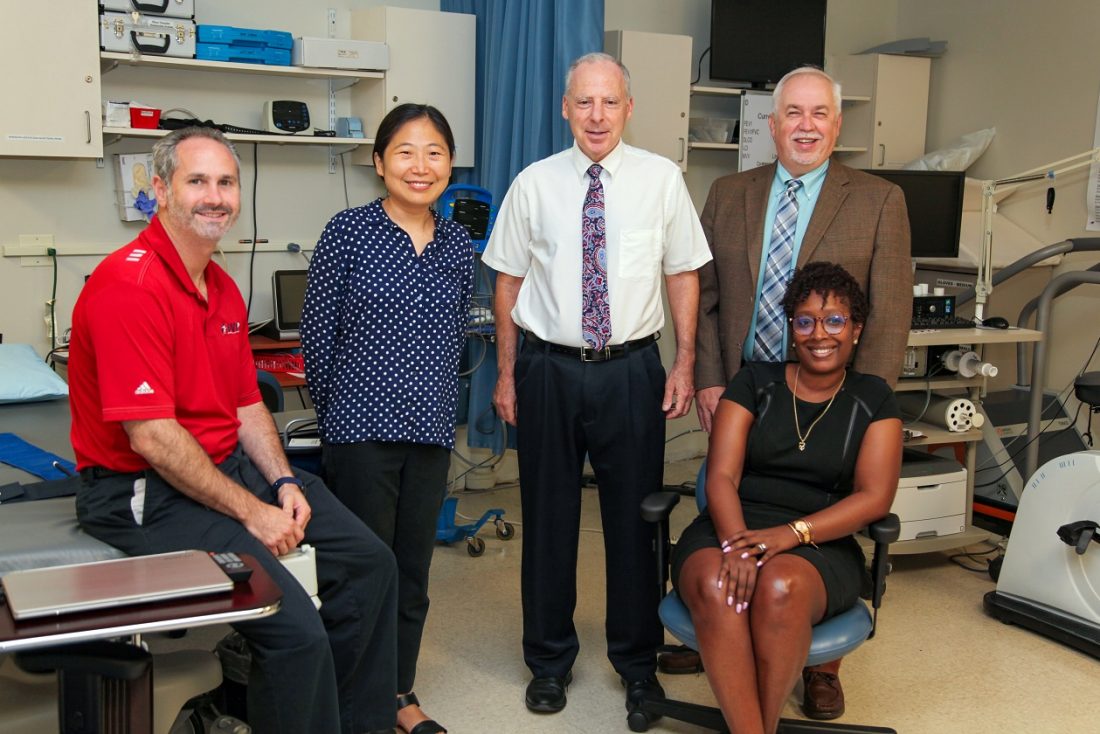Cardiovascular disease and cancer, the nation’s top two killers, share common ground like obesity and chronic inflammation, as well as a disproportionate impact on Black Americans. A new American Heart Association-funded center at the Medical College of Georgia is working to better understand the bidirectional dynamic, including how to intervene when, for example, cancer treatment itself results in heart problems.
MCG, the state’s public medical school, is one of four centers nationally funded by the $11 million AHA Strategically Focused Research Network on disparities in cardio-oncology, which also includes Boston University School of Medicine, the Medical College of Wisconsin and the University of Pennsylvania.
As part of the concerted, new initiative, MCG is conducting population, clinical and basic science research projects, like following patients with newly diagnosed prostate and breast cancer to look for early indicators that their cancer treatment is impacting their heart and looking at how factors like social inequities and obesity can predispose some individuals with cardiovascular disease to cancer, says Dr. Neal Weintraub, chief of the MCG Division of Cardiology, co-director of the Vascular Biology Center and director of the new AHA-funded center.
“We mostly are trying to understand the causes of the two conditions, how the intersection occurs and where we might be able to intervene and prevent it,” Weintraub says. “Once we understand the causes, and especially the disparities, that might lead to individualized approaches. Personalized medicine is kind of a buzzword but in essence that is what we are talking about.”
The new MCG center, funded by a $2.84 million grant through the new AHA Strategically Focused Research Network, also will support three postdoctoral fellows focused on the field of cardio-oncology for up to two years with an emphasis on underrepresented minorities, with the ultimate goal of ensuring the next generation of scientists focused on these important health intersections, Weintraub says.
Postdoctoral training will focus on cardiovascular physiology, cancer biology and statistical analysis under the leadership of Dr. David Stepp, vascular biologist and director of the vascular biology graduate program in the VBC, and the new center’s training director.
In partnership with Paine College, a historically Black college and MCG’s neighbor, the center also will have a research internship for STEM undergraduates from Paine that enables the undergrads to work directly with MCG clinicians, scientists and postdocs studying different aspects of the bidirectional relationship between the two common conditions, says Dr. Anna-Gay Nelson, chemist and faculty chemistry advisor at Paine and undergraduate training director for the center.
Many of her students have parents or other family members affected by cancer, heart disease and/or obesity, Nelson says, and many are also first- generation college students.
“We are moving from the side of them being afflicted to getting to the forefront and being part of the research,” she says, as Paine undergrads take a front row seat and role in explorations of the biological and environmental factors that may put them and their families at increased risk. “Now we are trying to get ahead of it,” Nelson says.
“We want to be there to support and help these students,” Weintraub says. “By giving them this opportunity, we hope they will see what their aspirational goals can be,” he says. “Why not say: I can be a physician-scientist.”
The MCG center is exploring likely contributors to increased risk like socioeconomic disparities, which can hinder healthy lifestyle habits like eating fresh fruits and vegetables and regular physical activity and health care, and promote obesity, exacerbate hypertension and related inflammation, and accelerate vascular aging, all risk factors for cardiovascular disease and cancer and the compounding consequences of both.
“We know many risk factors are shared between cardiovascular disease and cancer, but after you get cancer, mortality and morbidity are accelerated in African Americans and those who are obese,” says Dr. Ryan Harris, clinical exercise and vascular physiologist at MCG’s Georgia Prevention Institute and principal investigator on the center’s clinical science project.
Harris is looking at newly diagnosed patients with breast or prostate cancer in collaboration with Dr. Zach Klaassen, urologic oncologist, and Dr. Priyanka Raval, hematologist-oncologist specializing in breast cancer, both at MCG and the Georgia Cancer Center. Harris’ lab is doing complex testing — like measuring arterial stiffness and skeletal muscle health — periodically across 12 months to assess the cardiovascular impact of cancer treatment as well as the stress of a cancer diagnosis.
“We are looking at how vascular aging, inflammation and stress are affected over time after a cancer diagnosis,” Harris says. They want to better understand why Blacks have a greater cardiovascular impact and how, after a cancer diagnosis, adiposity affects vascular aging over time, he says, of the unique studies that are following both adult Black and white patients.
“These projects within the clinical populations will allow us to start understanding where we could target these risk factors or these vascular health outcomes to try to reduce the burden after they do get cancer,” Harris says.
The success of cancer treatment in the past decade is really driving the field of cardio-oncology, cardiologist Weintraub adds, as more patients with cancer live and doctors work to also resolve consequences of treatment, including a heightened risk of cardiovascular disease.
“As a cardiologist, you see people struggling with this all the time,” Weintraub says. But you also see great treatments for both cancer and cardiovascular disease, which provide optimism that more can be done, he says, and illustrate the need to pursue the tripartite mission of the new center.
The MCG center team plans to work collaboratively with other SFRN cardio-oncology centers to test new cancer therapies they identify to reduce cardiovascular impact in mice missing DARC, or Duffy antigen receptor for chemokines, a receptor on red blood cells that appears to protect from malaria but when mutated, as it is in about 70% of Blacks, can increase the risk for problems like obesity and inflammation.
As part of their basic science pursuits in the new center, Weintraub and his colleagues also will pursue their early evidence that the common DARC mutation in Blacks impacts their susceptibility to both cancer and cardiovascular disease. In fact, their DARC knockout mouse has similar indicators of the predispositions, like higher levels of chronic inflammation. They hypothesize that obesity and socioeconomic disparities in concert with the loss of DARC from the mutation, lead to increased obesity and inflammation in Blacks and heightened risk for cancer and cardiovascular disease.
The DARC mutation likely also impacts the efficacy and toxicity of cancer treatment in these individuals, Weintraub says. “Patients are surviving because our therapies are so much better in many different ways, so it becomes even more important now to prevent the cardiovascular disease or to be able to recognize it early and treat it,” he says.
One of his many long-term goals is to establish a cardio-oncology telehealth network that will enable physicians studying the unfortunate synergy to be readily available to physicians and patients, particularly in more underserved areas.
The center’s population science project is called reverse cardio-oncology because it’s exploring whether social inequities and health disparities that augment obesity also place both Black and white individuals with cardiovascular disease at higher risk for cancer. And, whether reduced DARC expression and associated higher inflammation, can predict which Black individuals with cardiovascular disease will also get cancer.
Co-principal investigators for these studies are Dr. Xiaoling Wang, genetic epidemiologist at the GPI, and Dr. Avirup Guha, who completed his medicine residency at MCG and AU Medical Center and is now a cardio-oncologist at University Hospitals Seidman Cancer Center in Cleveland and Case Western Reserve University School of Medicine.
Large databases like the NHANES-Medicare cohort will be used to parse these population health issues and help gain insight on whether people who have cardiovascular disease also are at increased risk for cancer, not necessarily because of their cardiovascular treatment, but because of common risk factors for both conditions, Wang says.
The MCG team will share relevant material from their multiple pursuits with the other new cardio-oncology centers, such as novel mouse models like the DARC knockout, human plasma/blood samples and population science databases.
 Augusta University
Augusta University




